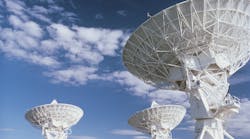Bandwidth is valuable, and much of it is unharnessed at higher frequencies. Great potential exists for high-data-rate communications using terahertz geostationary satellite communications (satcom) links—provided that atmospheric effects on propagation, including water vapor, can be overcome. To better understand these effects, researchers from the University of California at Santa Barbara developed detailed maps of the Earth’s surface with models of satellite link performance at terahertz frequencies. By locating satellite ground terminals in places that are generally dry, atmospheric attenuation can be significantly reduced. Data rates exceeding 1 TB/s were simulated on the modeled links.
Ground-terminal locations for such THz satellite systems must be carefully balanced with the physical and economic requirements for the infrastructure equipment required to route signals from the terminals to other communications networks. As the researchers point out, Antarctica is a popular location for astronomy research equipment, but would not be a feasible location for THz ground-terminal equipment, owing to the difficulty of transferring data from those ground terminals to other networks.
By combining a link budget and noise model with global water-vapor data and atmospheric models, the experimenters predict the feasibility of TB/s geostationary satcom links from various geographic terrestrial locations, as well as from airborne platforms. The models consider such factors as specific path geometries, modulation types, and variable bandwidths.
For example, noise modeling was performed for a number of different modulation formats commonly used in wireless communications systems, including quadrature phase-shift keying (QPSK), 16-state quadrature-amplitude modulation (16-QAM), 64-state QAM (64-QAM), and 64-state QAM (64-QAM). Optimum bandwidth was selected based on operating frequencies and water-vapor effects. Given the current rate of bandwidth consumption in wireless applications, the experiments point to a possible solution with these THz satcom systems. See “Modeling of Terabit Geostationary Terahertz Satellite Links from Globally Dry Locations,” IEEE Transactions on Terahertz Science and Technology, Vol. 5, No. 2, March, 2015, p. 299.
Looking for parts? Go to SourceESB.
